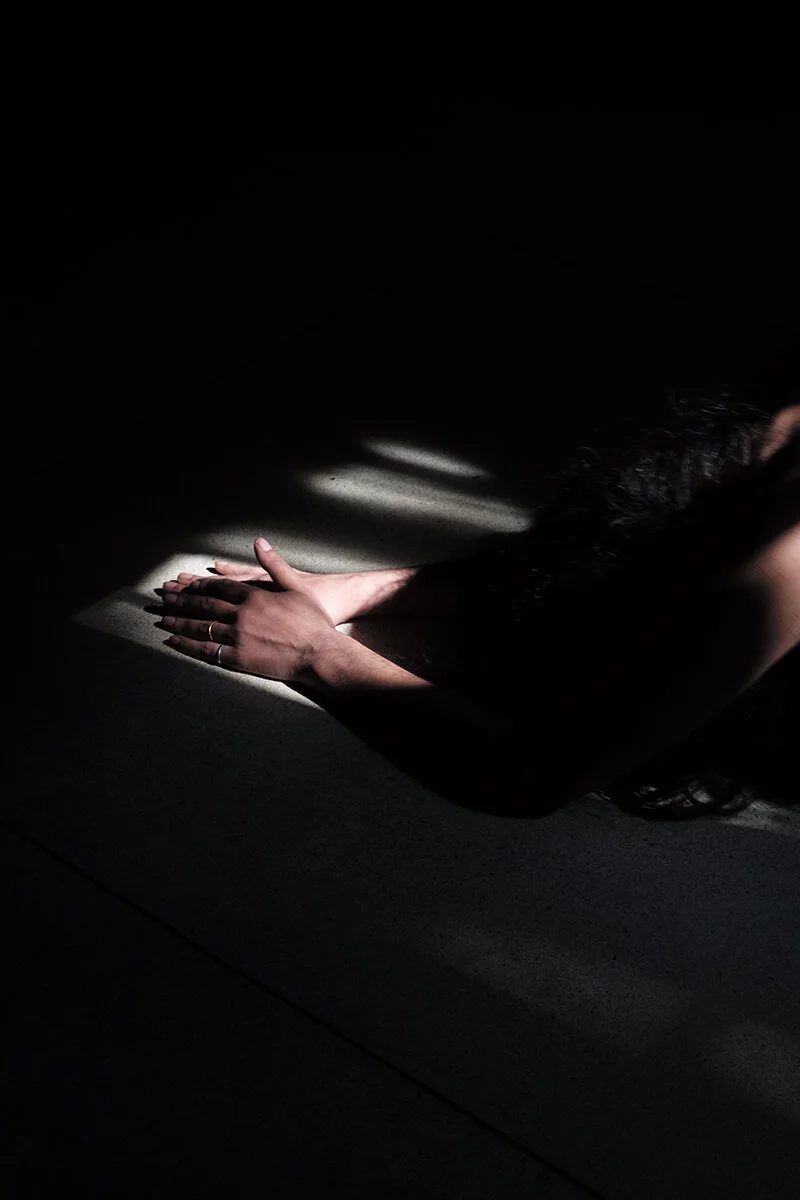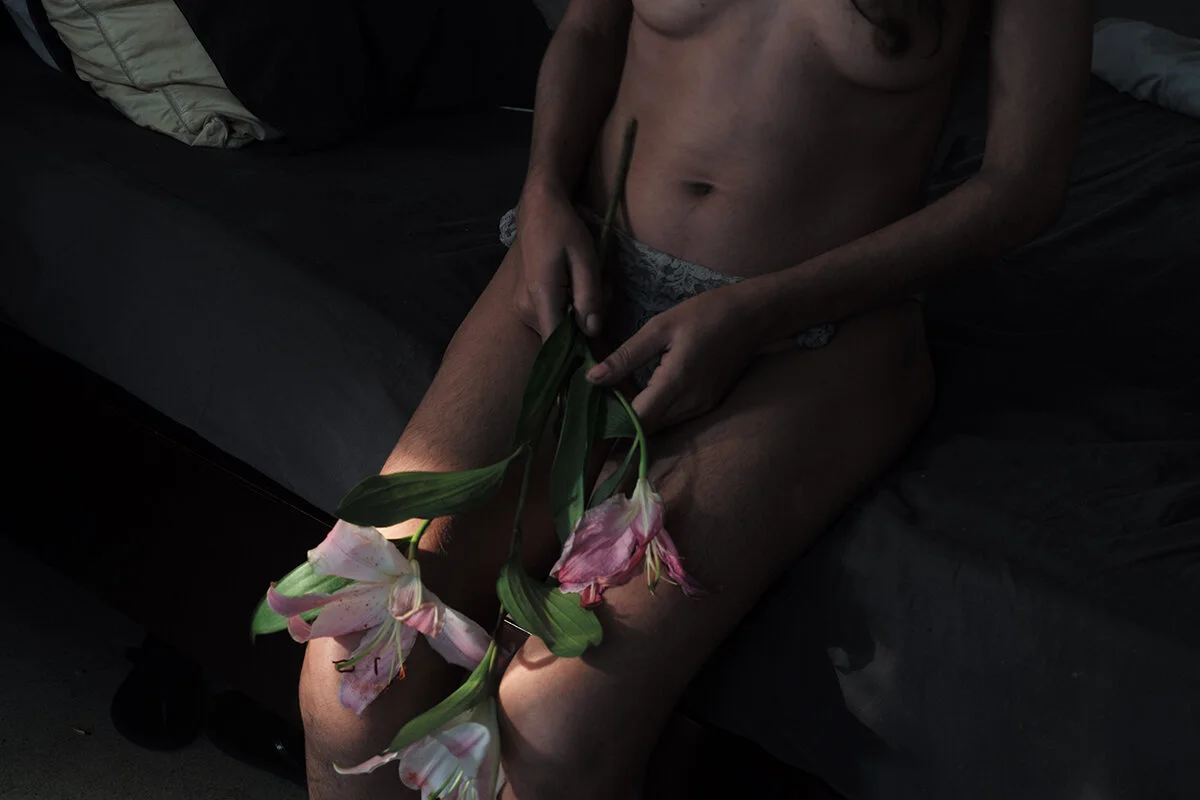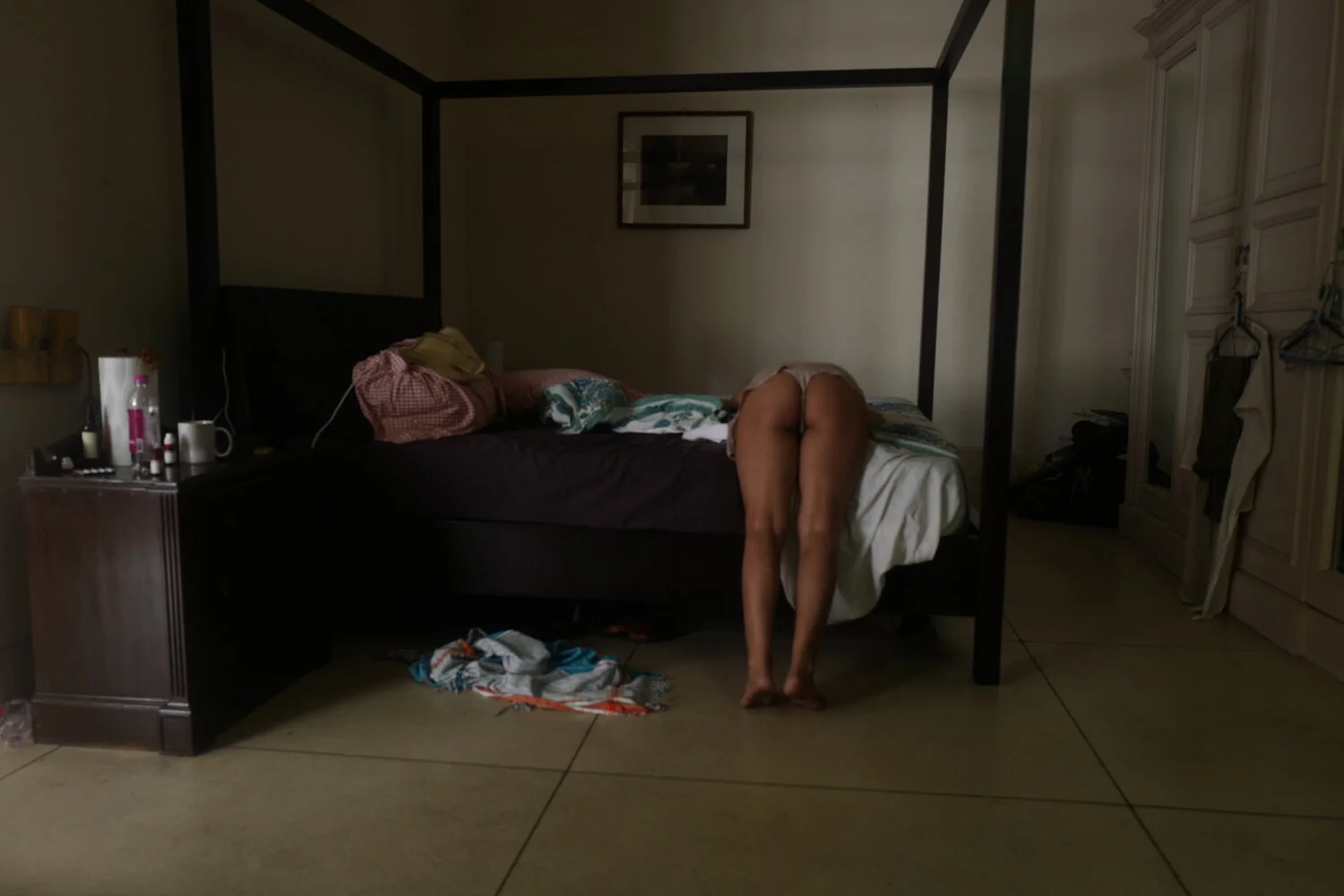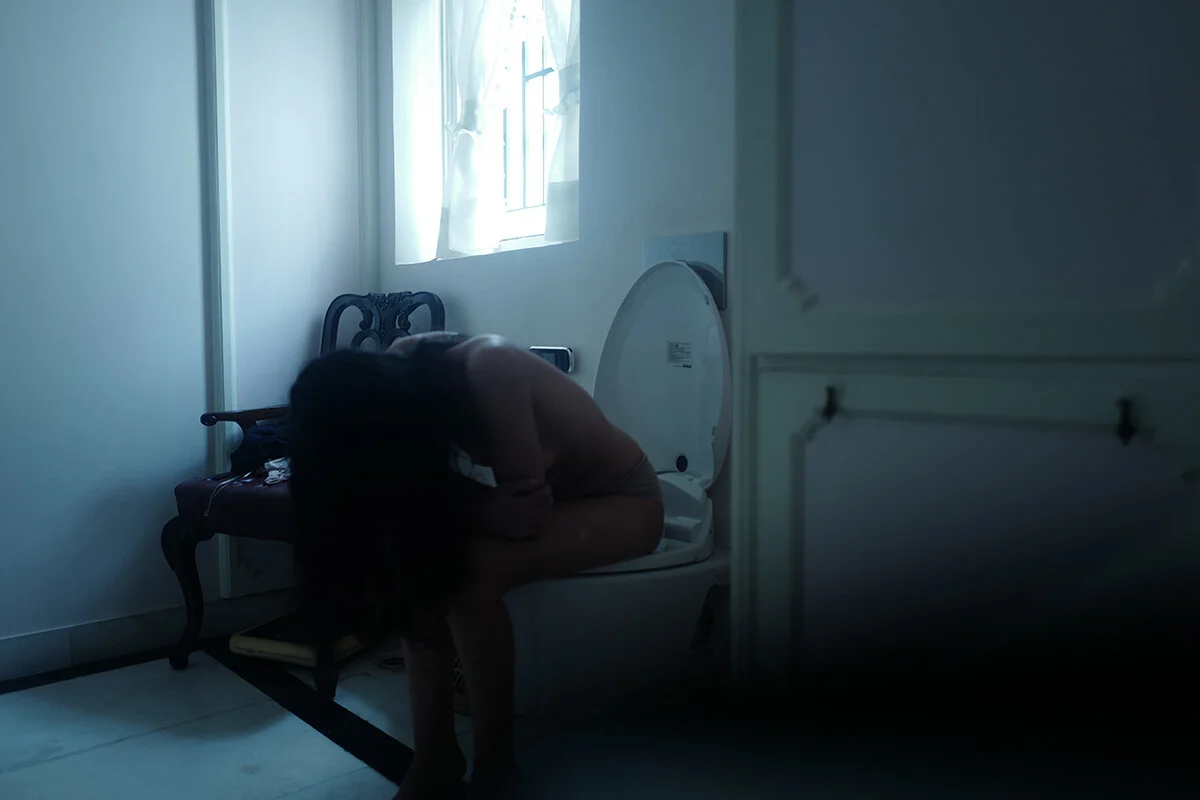© Buku Sarkar
Buku Sarkar’s “Containment Diaries” is a dark, revealing window into the photographer’s illness, crisis, and physical and emotional distress.
“I couldn’t get out of bed today, which is nothing new. I just couldn’t lift my neck from the pillow. I felt like I’d had a concussion. Electric sparks run up my spine. I can’t feel the tremors today. But when you are in the presence of others, you feel you must perform. So I do it, for the sake of my parents. Then perhaps every day has been a performance.”
When Buku Sarkar moved from New York City to New Delhi in 2013, she began suffering from a chronic undiagnosed medical condition. Her hands tremored, her body exhausted. She lost her balance, and frequently lost consciousness. She lived in constant pain for years, rarely leaving the house. When she did venture out, for a wedding or another family gathering, she had to rest for at least a day to harness the strength to avoid collapsing.
After keeping the condition – which she still suffers from today – quiet for years, and amidst quarantine adding an additional layer of distress, Sarkar began documenting it in a series of dark, revealing self-portraits titled “Containment Diaries.” Soaked in low light, often blurred by long exposures, Sarkar’s visual diary takes the viewer through her painful journey of nightmares, fear, panic, and tremors, with no visual end in sight. For Sarkar, it’s a letter to her family, friends, and the outside world – a means to communicate something she withheld for years. “It’s a way of way of showing you,” writes Sarkar, “how I really was when you never saw me, when I was alone in my apartment, surrounded by a beautiful garden I rarely entered.”
I spoke with Sarkar to learn more about her journey.
Editors note: Buku Sarkar is currently having a print sale on her website. If you are moved by her story and you’d like to support her work during this challenging time, check it out.
Jon Feinstein in conversation with Buku Sarkar
© Buku Sarkar
Jon Feinstein: I want to be respectful when I ask this question, given the nature of this series, but if you’re comfortable responding: how are you feeling?
Buku Sarkar: That is a question no one has asked me in a long time. The last time was in 2013. In fact, I had just tweeted about this: That with those who suffer chronic illness, you get asked- how are you? Did you eat? Meds? Docs? Etc. But no one actually asks ‘how are you feeling’. ‘What are you thinking?’ It’s a complicated question to ask someone who is still grappling with being partly dysfunctional.
To answer that- I’m feeling tired, angry, frustrated, and scared as hell about moving back to NY to live on my own, which is happening this summer.
Feinstein: Backing up a bit, much of your work, is personally and emotionally charged - and this new work feels even more inward. I’m curious about your starting point to translate those feelings visually…
Sarkar: I write fiction, which really is my first vocation, technically. And most of my stories look inwards into the characters and their minds. They’re not stories where something ‘happens’. They’re more internal. So perhaps it’s just something I’m naturally interested in. How the mind works.
I knew, when I started photographing in the slums, five or six years ago, even back then, that somehow my writing and photography would come together. I didn’t know when or how. And it happened really with this project. I’m very pleased about it, this new direction of looking inwards into people, be it me or another subject. I think I’m going to be exploring this realm for a while.
© Buku Sarkar
Feinstein: At what point did you decide this was something you wanted to share, or were comfortable sharing, with the world?
Sarkar: Right from the very beginning. I was so angry when I started this project, I wanted to do it in front of the whole world, in public. Many have seen it from its inception on IG and Twitter and only now does it come together coherently for them and they found that very interesting to see a project come to life in front of you.
You know, when you’ve been suffering for so long, and also once you start writing fiction, which is akin to taking your clothes off in the middle of Times Square, you lose all your inhibitions.
© Buku Sarkar
Feinstein: I remember seeing it originally on IG and have been moved to see your journey, for lack of a better word, manifest. We originally planned to discuss your Calcutta work, but as time went on, this became your main focus, your “driver” -- perhaps something that was all-encompassing, in a sense.
Sarkar: Yes, I wasn’t ready to really share it in a formal way at first. I think I was also being a little precious about it. But once you sent me the Calcutta questions, I realized how attached I am to the Diaries and I really wanted to share it with the world. Besides, HAF is one of my favorite platforms. And it feels special to have this series which is also very special to me, to be featured here.
© Buku Sarkar
Feinstein: Oh wow. Thank you! So let’s get further into this work. Tell me about the title “Containment Diaries” -- what are its origins/ how did you come up with it?
Sarkar: I moved in with my parents during the lockdown as it would be easier to stay with them. They have a large garden for the dog. I didn’t think I could manage on my own with no help at all. I started writing a memoir about the Diaries, only, it’s called The Lockdown. It’s halfway done but I get tired very easily when writing. And then I just collapsed, quite badly and I got so frustrated, I thought, to hell with it. If I’m going to live with this thing, I’m going to record it, and publicly. I want everyone to know. I wanted to shout it out. And then I began to enjoy it so much, something uplifting and creative to do.
© Buku Sarkar
Feinstein: There is a bit of nudity in the work, which I understand has created issues on Instagram…
Sarkar: The nudity wasn’t part of the plan at all. The very first images on my website, where I fall over the bed and you can see my bum-that wasn’t meant to be seductive in any way. That was one of the first images I took. I had no plan whatsoever. I set the camera timer and went over to the bed and thought, what do I do now? And then I figured, well I’ll do what I always do--collapse. That was actually an image of me collapsing in real-time. Strange, isn’t it how reality and fiction mix together so seamlessly?
The nudity happened later, much by accident. I found a lovely image I had taken of my twin some years ago and you can see her dark, naked silhouette. But she refused to let me use it and then I thought, oh, maybe I can reenact it again myself. And you know, gradually I came to realize this project is not just about recording my daily struggles but about reclaiming my body, my spirit.
That’s really what it’s about. The body has always been very important to me, as an ex-athlete perhaps. But I do everything through my body. Maybe we all do, I don’t know. I write, feel, move, listen to music, know if I’m sleepy-- all through ‘feeling and touch’. Then to lose that touch, sensation, makes one feel numb. Like you’ve lost yourself. This is, in a way, is an attempt of trying to get me back. Get back all the important things to me. And that’s why it’s an important project. Not really for its documentation element, but more its affirmation of life.
© Buku Sarkar
Feinstein: Before knowing much about this work, from the title, I thought it was about social isolation related to Covid/quarantine… but then reading about it, I learned it’s clearly otherwise. That being said, do you see parallels to the past year of quarantine?
Sarkar: Of course. That’s why I kept the name. Being in lockdown, in prison, unable to go out. I’ve spent months at a time in bed. I’ve been in lockdown since 2013. Secretly I was happy others had to stay in too. I felt my misery was being shared, finally. Do you know how it feels to see the world go on doing their thing--going to the park, the movies, dinner, a drink, a walk. I haven’t done any of those simple things on a regular basis for seven years. It kills you deep inside. And you can’t even tell anyone. You can’t blame others for your misery.
© Buku Sarkar
Feinstein: Has quarantine changed how you think about this work and your illness, depression…?
Sarkar: No. Only slyly happy as I said above that everyone else was a prisoner like I was. I did do a lot of work during that period. More than I have in ten years. I don’t know why. It’s not like anything in my life had changed after the lockdown. It’s exactly as it was since 2013. I think the stress of moving back with my parents must have prompted me to keep my head low and work. They’re very hyper people.
Feinstein: In your writing about this work, you use the words “Then perhaps every day has been a performance.” - I think there’s an interesting parallel between these words and the images -the relationship between performing daily routines for the sake of staying alive, and then the potentially performative nature of self-portraiture… Would you agree/ are you comfortable discussing?
Sarkar: That’s interesting. I hadn’t seen it like that. Most of the images were all unplanned. I’d say in 90% of them, I did not know what I was going to do till the actual moment. It was all very spontaneous.
I guess what I mean by perforative, is just that there is an awareness of photographing yourself…
And when I ran out of ideas of what to do- just collapse. I do that so well. But you’re right, it’s an interesting parallel. Besides, aren’t all portraits in some way performative?
© Buku Sarkar
Feinstein: Completely!
Sarker: This is a series not just about what is happening to me but about what I want to happen to me; my deepest fears as well as my most inner dreams. It’s as much documentary as it is fiction. I’ve completely outed myself in this project and in fiction you bare yourself to the world. . So performance--this kind at least--really has an element of reality and truth to it. Does that make sense?
Feinstein: Absolutely. I’m interested in your use of light. It’s at times gritty, at times soft, blurred, always dark, and always poetic. Can you talk a bit about your approach and relationship to light as a metaphor?
Sarkar: I don’t know how to answer that. It comes naturally most of the time. I like the mystery and poetry of light; the ambiguity. I think, again, as a writer, the backdrop becomes very important; the description. It sets the tone for what’s to come. I’ve tried lighter, less dark images but it’s always the dark ones and the night ones that come out the best. Maybe you, as the viewer can explain the metaphor better.
My Creative Writing teacher at my MFA once told me: don’t work so hard on the metaphors. No one but you will read into them anyway.
So I would say, it’s not intentional, this way of using light. It’s more reactive and instinctive. That being said, it is a dark and disturbing story so I wanted the images haunting and ghostly. A feeling that I am there but not there.
Feinstein: I think, possibly to your writing teacher’s point, these metaphors may be just transpiring organically. You mentioned that when you started to share this work online via Instagram, you received an outpouring of positive responses - many women writing to you that the work moved them tremendously.
Did this change how you thought about the work and its larger implications/ potential to connect?
Sarkar: Yes, it made me feel immensely empowered and encouraged--that I was, indeed, going in the right direction. I had no idea what I was doing at first. I’ve barely taken three selfies in my life, and now with no clothes on. If you told me a year ago I’d be doing this, I’d have laughed. But all these messages, from strangers, old high school friends I haven’t seen in decades. It just gave me the confidence to carry on doing what I was. To trust my instincts.
© Buku Sarkar
Feinstein: Could you share a particularly moving response that you’ve received so far?
Sarkar: Sure - here’s one: “Hey! I have been passionately following your recent work here on Instagram. First off, kudos for so skillfully balancing the raw honesty in the series with elements of out-of-body surrealness. Reading about your undiagnosed (contd) medical condition certainly added to the effect that these photos evoke. Especially so, because I myself have been, for the last six years living with an undiagnosed condition. These photos mean so much 🙌”
© Buku Sarkar
Feinstein: That’s amazing and really meaningful. As I imagine you are continuing to make these images on an ongoing basis – is there an endpoint?
Sarkar: I was thinking the same thing. I didn’t know at first. When would this end? How would this end? A friend told me, you’ll know when it’s over. And I did. It just felt finished at some point, or the images began to get repetitive and I knew it was time to stop. Now to the edit room.
I must have made thousands of images in two months over this. And I’m still doing them, now and then, although not necessarily for the series. My next project will take this forward and do something similar with 3 or 4 subjects whom I’m very close to. Not those who have a chronic illness but those who aren’t afraid to show their real selves in front of the camera. Again, a raw, honest yet performative act. A combination of what’s real and what’s not.
Feinstein: Has making the work so far given you a sense of closure? Is closure possible?
Sarkar: To let yourself go and yet imagine who you are and who you want to be, which is a form of letting go but also of holding back. But I have to find the right subjects for that. I’ve already found two. Let’s see how it goes. I’m excited about this new direction.













